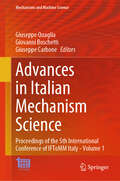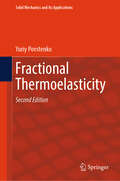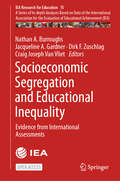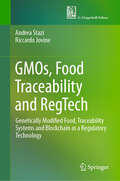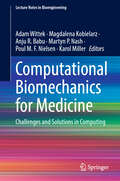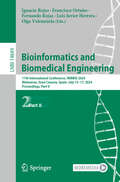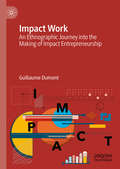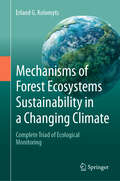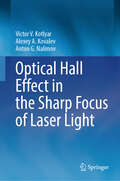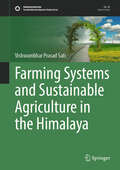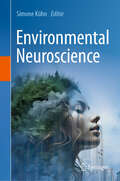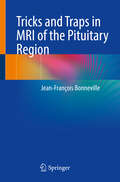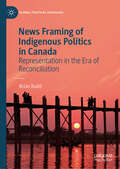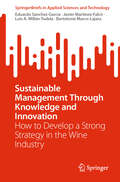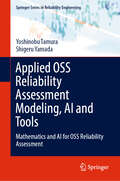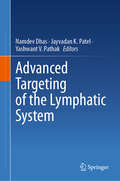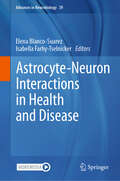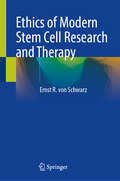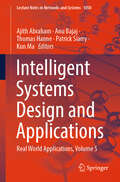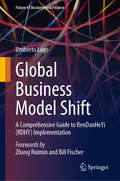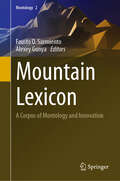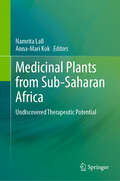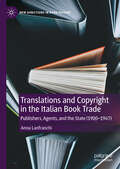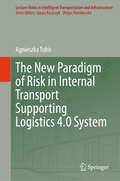- Table View
- List View
Advances in Italian Mechanism Science: Proceedings of the 5th International Conference of IFToMM Italy - Volume 1 (Mechanisms and Machine Science #163)
by Giuseppe Carbone Giovanni Boschetti Giuseppe QuagliaThis book presents the proceedings of the 5th International Conference of IFToMM ITALY (IFIT), held in Turin, Italy on September 11–13, 2024. It includes peer-reviewed papers on the latest advances in mechanism and machine science, discussing topics such as biomechanical engineering, computational kinematics, the history of mechanism and machine science, gearing and transmissions, multi-body dynamics, robotics and mechatronics, the dynamics of machinery, tribology, vibrations, rotor dynamics and vehicle dynamics. A valuable, up-to-date resource, it offers an essential overview of the subject for scientists and practitioners alike and inspires further investigations and research.
Fractional Thermoelasticity (Solid Mechanics and Its Applications #278)
by Yuriy PovstenkoThis new edition offers expanded coverage of fractional calculus, including Riemann–Liouville fractional integrals, Riemann–Liouville and Caputo fractional derivatives, Riesz fractional operators, and Mittag-Leffler and Wright functions. Additionally, it provides a comprehensive examination of fractional heat conduction and related theories of thermoelasticity. Readers will gain insights into the concepts of time and space nonlocality and their impact on the generalizations of Fourier's law in thermoelasticity. This edition presents a detailed formulation of the problem of heat conduction in different domains and the associated thermal stresses, covering topics such as the fundamental solution to the Dirichlet problem, constant boundary conditions for temperature, and the fundamental solution to the physical Neumann problem. New insights into time-harmonic heat impact on the boundary have also been added. Cracks in the framework of fractional thermoelasticity are also considered.
Socioeconomic Segregation and Educational Inequality: Evidence from International Assessments (IEA Research for Education #15)
by Nathan A. Burroughs Jacqueline A. Gardner Dirk F. Zuschlag Craig Joseph Van VlietThis open access book uses multiple IEA Assessments to examine the relationship between socioeconomic segregation between classrooms and student outcomes. By examining Socioeconomic status (SES) segregation between classrooms as well as between schools, it produces a more accurate estimate of student sorting. Further, this study examines the differential impact of student sorting across subject areas and grades in order to explore whether school structure’s relationship to educational inequality exhibits content and longitudinal heterogeneity. This study employs time series, fixed-effect, random-effects, and synthetic-cohort methods to comprehensively investigate the robustness of the relationship between SES segregation and achievement inequalities. This project makes an important contribution to researchers’ understanding of student sorting’s impact using a comparative lens, while also providing important information to policymakers on the role of schools in mediating social inequalities.
GMOs, Food Traceability and RegTech: Genetically Modified Food, Traceability Systems and Blockchain as a Regulatory Technology
by Andrea Stazi Riccardo JovineThe book deals with the regulation of GMOs within the context of multiple principles and interests, including food security, sustainable development, and biodiversity. The recognition of intellectual property rights, particularly with respect to geographical indications and patentability is also discussed. From a comparative perspective, the importance of traceability in the food industry, driven by major world powers' consumer and market protection policies, is highlighted. Finally the use of emerging technologies, such as blockchain, as a form of "regulatory technology" for more effective and sustainable management of traceability systems within the food supply chain, is explored as a workable and forward looking solution.
Computational Biomechanics for Medicine: Challenges and Solutions in Computing (Lecture Notes in Bioengineering)
by Karol Miller Adam Wittek Poul M. F. Nielsen Martyn P. Nash Magdalena Kobielarz Anju R. BabuThis book presents peer-reviewed contributions from the MICCAI 2023 Computational Biomechanics for Medicine CBM XVIII Workshop held in conjunction with the 26th International MICCAI Conference. The content focuses on applications of computational biomechanics to computer-integrated medicine, which includes medical image computing, application of machine learning in image analysis and biomechanics, atlas based biomechanical simulations, novel algorithms of computational biomechanics and experimental methods for analysis of disease and injury mechanisms. The book details state-of-the-art progress in the above fields to researchers, students, and professionals.
Bioinformatics and Biomedical Engineering: 11th International Conference, IWBBIO 2024, Meloneras, Gran Canaria, Spain, July 15–17, 2024, Proceedings, Part II (Lecture Notes in Computer Science #14849)
by Ignacio Rojas Francisco Ortuño Olga Valenzuela Fernando Rojas Luis Javier HerreraThis volume constitutes the proceedings of the 11th International Work-Conference on IWBBIO 2023, held in Meloneras, Gran Canaria, Spain, during July 15-17, 2022. The 54 full papers were carefully reviewed and selected from 148 submissions. They were organized in the following topical sections: Healthcare and Diseases, Machine Learning in Bioinformatics, New Advances in Deep Learning in Bioinformatics and Biomedicine, Novel Methodologies and Applications in Bioinformatics and Biomedicine.
Impact Work: An Ethnographic Journey into the Making of Impact Entrepreneurship
by Guillaume DumontThis book provides a critical, ethnographically grounded examination of the hype surrounding the idea of impact by investigating the work of those attempting to create innovative social ventures. Through in-depth immersion in the day-to-day running of a social impact accelerator, Guillaume Dumont reveals the intricate, behind-the-scenes socialization through which entrepreneurs learn the ropes of impact entrepreneurship and sheds light on the roles of some of the key players of this unique social world. The book challenges the view that impact is a given property of a venture resulting from an intrinsic desire to change the world embodied by gifted and compassionate entrepreneurs. Instead, Dumont argues that impact emerges iteratively from a process of social engagement and negotiation among entrepreneurs, investors, corporate executives, and mentors as they collaborate in the mundane processes of its production, what he calls “Impact work.” This book, therefore, is about impact in the making. It is a story of hope and collaboration unveiling the social and cultural challenges and contradictions faced by those attempting to create alternative organizations addressing social and commercial goals.
Mechanisms of Forest Ecosystems Sustainability in a Changing Climate: Complete Triad of Ecological Monitoring
by Erland G. KolomytsThe author's working concept of geo-ecological monitoring is presented. For the first time, the full triad of monitoring in its classical definition is considered: "observation (state assessment) – control (prediction) – management (adaptation, feedback, regulation)". The strategic goal of described monitoring research is to reveal the environmental otential of sustainablility of forest ecosystems in the context of modern global warming. The monograph expounds the main statements of author’s topo-ecological predictive concept: “Global Changes on the Local Level”, as a basis of ground bio-ecological and geosystem monitoring of natural ecosystems under global anthropogenic climatic changes. This concept makes it possible to carry out local empirical simulation of the regional bioclimatic trend and thereby reveal the mechanisms of transmission of global and regional climate signals to the local level. On the example of the Volga River basin, predictive empirical-statistical models of the carbon balance of forest ecosytems are presented under conditions of a changing climate. The carbon content in various pools of boreal and nemoral forests were calculated. The global climate models give prognostic estimates of the components of them carbon balance. A quantitative assessment of the ecological resources of forest formations that provide the environment sustainability through mechanisms of regulation of the carbon cycle is given. The adaptation of forest ecosystems to climate change is described through the calculated parameters of their functional sustainability.
Optical Hall Effect in the Sharp Focus of Laser Light
by Victor V. Kotlyar Alexey A. Kovalev Anton G. NalimovThis book explores the optical Hall effect in the sharp focus of laser light. It builds upon the established theory of Richards-Wolf (1959), providing numerous real-world examples that illustrate both spin and orbital Hall effects near the focal point. Within the focal zone, distinct regions of left and right circular polarization emerge, showcasing the orbital Hall effect. This effect becomes apparent when localized areas within the focal plane experience transverse energy flow, rotating either clockwise or counterclockwise. The spin Hall effect, a fundamental occurrence, is demonstrated when a linearly polarized Gaussian beam is concentrated. Furthermore, the book reveals spin and orbital Hall effects in light fields with nonuniform linear polarization, where the polarization direction varies within the beam cross section. While the optical or photonic Hall effect has been recognized since 2004, a comprehensive monograph detailing its focal dynamics has been lacking until now. Drawing from the cohesive theoretical framework of the Richards-Wolf theory, this book offers specific examples and results from computer modeling. It equips readers with analytical relations for calculating energy and spin fluxes near a sharp focus across various initial light vector fields. Designed for a diverse audience, including scientists, engineers, and students in optics and photonics, this book serves as a valuable resource. It caters to undergraduate and graduate students in applied mathematics, physics, informatics, and optics, and can also benefit researchers and professionals in the field. Moreover, the book holds potential as a foundational text for advanced graduate courses
Farming Systems and Sustainable Agriculture in the Himalaya (Sustainable Development Goals Series)
by Vishwambhar Prasad SatiThe farming system in the Central Himalayan Region is distinctive and unique, mainly focusing on the cultivation of traditional subsistence cereal crops. The agrobiodiversity in this region is rich, with the Central Himalaya growing numerous cultivars and crop races. The practice of cultivating many crops or cultivars in a single field is known as the 'Barahnaja System.' Another peculiar system is the Sar/Sari system, where different crops grow in the two Sars during the same seasons, with one Sar left fallow for six months while the other grows crops. This century-old farming method involves plowing fields with oxen and using organic manure to enhance crop production and productivity. However, recent changes have been observed in the farming systems. The area under traditionally growing millets is declining. In river valleys and middle altitudes, there is a recent trend towards cultivating paddy and wheat. Unfortunately, the cultivation of temperate fruits – apple and citrus has seen a decline in terms of area, production, and productivity. Various factors are influ encing farming systems in the Central Himalaya, such as high climate variability and change, decreasing crop production and productivity, evolving food habits, and out-migration. The book contains 12 chapters illustrating introduction, land use and land cover change, cropping patterns, crop diversity and agro-ecological zones, farming systems and sustainable agriculture, climate change and its impact on agriculture, infrastructural facilities for sustainable agriculture, declining agriculture: a case study, crop productivity and suitability analyzes, agribusiness, policies and planning for sustainable agriculture, and conclusions. It serves as a valuable resource for students, academicians, researchers, policymakers, and farmers.
Environmental Neuroscience
by Simone KühnThis important new book presents an introduction to Environmental Neuroscience, an emerging field devoted to the study of brain-mediated bidirectional relationships between organisms and their physical environments. Environmental Neuroscience offers a novel perspective in the human neurosciences, which have typically focused on the individual isolated from its natural habitat. The book presents the theoretical background of the field, discusses how the environment impacts humans and how humans impact the environment, explores the neuroscience of the built environment, and addresses special populations and presents different methodological approaches. Environmental Neuroscience bringing together the top authorities in the field, will appeal to neuroscientists and to a range of scholars from public health, urban studies, human geography, and architecture who are searching for guidance on what characterizes a health-promoting environment.
Tricks and Traps in MRI of the Pituitary Region
by Jean-François BonnevilleThis book describes the challenges occurring during a pituitary examination and provides key pieces for diagnosis. It takes into account unusual issues encountered when reading a pituitary MRI. Each chapter covers the common traps faced during the interpretation of pituitary MRI, for instance, in the presence of pituitary adenomas, Rathke cleft cysts, craniopharyngiomas, and many other pathological conditions, before offering solutions to come to the correct diagnosis. This concise practical guide offers helpful information for radiologists and neurosurgeons, but the book will also interest endocrinologists and internists.
Strategic Crisis Leadership in the Middle East: Covid-19 and Lebanon
by Alessia TortoliniThis book assesses strategic crisis management in Lebanon during the Covid-19 pandemic. It compares the government’s responses to the crisis with those offered by Hezbollah, and assesses how their varying responses were perceived by the public. By shining light on the case of Lebanon, the book broadens our understanding of crisis management into a region that, due to social and political complexity, has been vastly understudied. It will appeal to scholars and students of public administration, crisis management and international relations, as well as all those interested in the Middle East more generally.
News Framing of Indigenous Politics in Canada: Representation in the Era of Reconciliation (Global Political Sociology)
by Brian BuddThis book explores the news media’s coverage of Indigenous-settler reconciliation following the conclusion of the Truth and Reconciliation Commission of Canada (TRC). Using a comparative case study research design, the book examines news coverage of three significant Indigenous rights issues and events during the post-TRC era. The findings presented demonstrate that in the post-TRC era, the Canadian news media continue to produce systemic patterns in coverage which reject, marginalize and erase the territorial rights and claims of Indigenous Peoples. The author concludes that rather than helping to move the relationship between Indigenous Peoples and settlers forward along a path of reconciliation, power-sharing, and the resurgence of land-based self-determination, the news media are continuing to construct discourses and representations that work against the political objectives of Indigenous Peoples and reinforce settler colonial power relationships in Canada.
Sustainable Management Through Knowledge and Innovation: How to Develop a Strong Strategy in the Wine Industry (SpringerBriefs in Applied Sciences and Technology)
by Javier Martínez-Falcó Bartolomé Marco-Lajara Eduardo Sánchez-García Luis A. Millán-TudelaThis book explores multiple types of innovation within the modern wine industry and how it has developed historically. The book provides and extensive examination of the existing knowledge in this subject. This highlights the evolution of historical and contemporary trends and signposts the authoritative literature published and most important researchers active in the field. With this comprehensive approach, the book is a versatile resource for both scholars and industry professionals, akin to a "Swiss Army Knife" for all aspects of green innovation in the wine sector.
Applied OSS Reliability Assessment Modeling, AI and Tools: Mathematics and AI for OSS Reliability Assessment (Springer Series in Reliability Engineering)
by Shigeru Yamada Yoshinobu TamuraThis textbook introduces the theory and application of open source software (OSS) reliability. The measurement and management of open source software are essential to produce and maintain quality and reliable systems while using open source software. This book describes the latest methods for the reliability assessment of open source software. It presents the state of the art of open source software reliability measurement and assessment based on stochastic modeling and deep learning approaches. It introduces several stochastic reliability analyses of OSS computing with application along with actual OSS project data. The book contains exercises to aid learning and is useful for graduate students and researchers.
Advanced Targeting of the Lymphatic System
by Jayvadan K. Patel Yashwant V. Pathak Namdev DhasThis book goes in depth about the lymphatic system and the functions of the lymphatic organs, lymphatic tissues, and lymphatic vessels. The book addresses various types of diseases in which the lymphatic system can act as a targeting site for drug absorption and suggests strategies to treat these different infections of the lymphatic system. This book is intended for academicians who work in fields related to the lymphatic system, novel drug delivery systems, pharmaceutical science, novel-material sciences, as well as professionals in the medical, nursing, or other health care industries.
Astrocyte-Neuron Interactions in Health and Disease (Advances in Neurobiology #39)
by Elena Blanco-Suarez Isabella Farhy-TselnickerThis new book extensively explores a range of topics related to astrocyte-neuron interactions under multiple conditions, in both health and disease. These include the types of interactions that occur during development and the establishment of neuronal circuits that underlie learning and memory formation in various animal models as well as humans. Furthermore, the book addresses topics on how these interactions go awry in disease and injury. In addition, the authors propose inspiring new avenues to explore therapeutic approaches using astrocytes as targets. A cadre of international experts presents a broad range of views on the state-of-the-art of astrocyte-neuron interactions.
Ethics of Modern Stem Cell Research and Therapy
by Ernst R. von SchwarzThis book provides an authoritative and comprehensive overview on the ethical issues surrounding the most promising and most controversially discussed topic in modern biotechnology and medicine, stem cell therapy. It is written by a scientist who has been involved in the basic research of stem cell therapy for over 20 years and was part of the initial experimental studies demonstrating benefits and damage repair using stem cells, and who also is a clinical cardiologist involved in the clinical studies of stem cell therapy in patients with mainly cardiovascular and neurodegenerative diseases from its early stage until now. The book starts with a brief overview of the history of stem cell research, the administrative and regulatory aspects including the federal governmental changes with every political administration over the last 20 years, and the stand of the FDA on research and therapy. It also discusses the issues of medical tourism, patient funded studies, false marketing claims, and the ethical and religious aspects of stem cell research, anti aging research, and immortality research including the Roman Catholic Churches view on embryonic stem cells. Ethics of Modern Stem Cell Research and Therapy will be a valuable resource for clinicians, physicians, and researchers who are looking to either conduct or use stem cell therapies. It offers a one-stop guide to the current regulations of the FDA as well as the potential that stem cell therapies have on many degenerative diseases.
Intelligent Systems Design and Applications: Real World Applications, Volume 5 (Lecture Notes in Networks and Systems #1050)
by Ajith Abraham Patrick Siarry Thomas Hanne Kun Ma Anu BajajThis book highlights recent research on intelligent systems and nature-inspired computing. It presents 47 selected papers focused on Real-World Applications from the 23rd International Conference on Intelligent Systems Design and Applications (ISDA 2023), which was held in 5 different cities namely Olten, Switzerland; Porto, Portugal; Kaunas, Lithuania; Greater Noida, India; Kochi, India and in online mode. The ISDA is a premier conference in the field of artificial intelligence, and the latest installment brought together researchers, engineers, and practitioners whose work involves intelligent systems and their applications in industry. ISDA 2023 had contributions by authors from 64 countries. This book offers a valuable reference guide for all specialists, scientists, academicians, researchers, students, and practitioners in the field of artificial intelligence and real-world applications.
Global Business Model Shift: A Comprehensive Guide to RenDanHeYi (RDHY) Implementation (Future of Business and Finance)
by Umberto LagoThis book takes the readers on a profound exploration of global business transformation through the lens of the RenDanHeYi (RDHY) business model. It discusses the complexities of implementing RDHY beyond China and navigating cultural, regulatory, and organizational intricacies. It helps uncover the pragmatic and outcome-oriented nature of RDHY, with a focus on aligning core values for sustainable success. Using a multidimensional analysis, the author reveals hidden layers of values, philosophies, and principles that underpin successful business models. For leaders and managers navigating the challenges of genuine transformation, this resource offers a comprehensive roadmap, transcending surface-level changes to foster authentic and enduring success in the dynamic landscape of global business innovation.
Mountain Lexicon: A Corpus of Montology and Innovation (Montology #2)
by Fausto O. Sarmiento Alexey GunyaThis book is the second volume in a series on montology dedicated to the transdisciplinary reflection of mountain research, considering the diversity of views on mountains and their problemata in the context of rapid technological development and unprecedented accumulation and dissemination of information around the world. The necessity for a new orderly and structured lexicon arose from the need to critically reassess the colonial past in the development of mountain territories, the development of a new and alternative understanding of mountain topics in the light of decolonized epistemology. The creation of coordinated and ordered terms for the main parts of mountain research creates the basis for an unorthodox understanding of the ontology of mountains and helps to better understand the complex cultural and natural essence of mountain socio-ecological systems. At the same time, a local episteme of mountains, considering local values, small scales, and vernacular visions are of particular importance, which must be taken into account in the current terminology. The purpose of the book is to provide methodological support for montology as a convergent and transdisciplinary science of mountains, based on the harmonization of its terminological base. The book pays special attention to onomastics, toponymy, standardization and other nuances of terms used in mountain research. According to this goal, three dozen articles in a relatively small format (about 3 pages) vividly, attractively and innovatively reflect the modern view of one or more related terms. Articles include definition(s) of the term, description of etymology, onomastics or toponymy used, examples of local characteristics compared to traditional sources, possible vernacular terms. Articles are grouped into four main areas: 1) Basic glossary of montology terminology, 2) Towards mountain socio-ecological systems, 3) Innovative disciplinary systemic realm, 4) Mountain classifications, onomastics, critical toponomy and rediscovery of meaning. The authors of the articles are leading experts in the field of mountain research from around the world. The book is intended for scientists, experts and teachers. It is provided with an annotated list of the most important montology terms.
Medicinal Plants from Sub-Saharan Africa: Undiscovered Therapeutic Potential
by Namrita Lall Anna-Mari KokSouth Africa boasts high biodiversity among its flora and this is associated with many undiscovered medicinal plants with therapeutic potential. To target this untapped resource, the first step is to introduce these species to a wider spectrum of audience, be they the academics who carry out research, students interested in holistic medicine and healing, or those working in the natural product industry. In this work, we document a list of medicinal plants from Sub-Saharan Africa that have been underestimated in their therapeutic value and not thoroughly studied. Our book contains the recent scientific studies and validation on the individual plants. Written and organised in an easily accessible way, each entry includes specific information on the plant’s distribution, traditional usage and their phytochemical content. In summary, this book introduces new and exciting plants of Sub-Saharan Africa in a comprehensive and well-thought-out format for academia, pharmacists, clinicians, complementary and alternative medicine practitioners, traditional healers, industry and the general experienced or novice botanist.
Translations and Copyright in the Italian Book Trade: Publishers, Agents, and the State (1900-1947) (New Directions in Book History)
by Anna LanfranchiThe 19th-century copyright revolution gave authors and translators powerful tools over the use of their works. It encouraged publishers to form networks that connected them to writers, translators, authors’ societies, and literary agents worldwide. This book argues that the development of international frameworks for the protection of literary property represented a watershed in the transnational circulation of texts in translation. Through the lens of the post-Unification Italian translation market of British and US authors (1900-1947), it combines a copyright historical approach to book history with a systematic survey of British and Italian archives. It positions the Italian publishing industry within the broader European and transatlantic copyright market to explore the cultural, social, and political value of translation rights, offering a new interpretative key to the transnational nature of the modern book trade.
The New Paradigm of Risk in Internal Transport Supporting Logistics 4.0 System (Lecture Notes in Intelligent Transportation and Infrastructure)
by Agnieszka TubisThis book proposes a new approach to risk assessment in internal transport supporting material flows in the Logistics 4.0 system. The development of Industry 4.0 and the accompanying digitization of processes in organizations cause changes related to the functioning of production and supporting systems. As the research proves, one of the areas of such change is the evolution of the risk occurring in logistics processes. Despite the growing number of publications on risk assessment in Logistics 4.0 systems, the research focuses solely on technical aspects related to the maintenance of cyber-physical systems or organizational issues related to planning the operation of these systems. However, the currently developed Logistics 4.0 systems are complex cyber-human-technical system, requiring an interdisciplinary approach to assessing the risk associated with their operation. The literature research conducted by the author showed a clear research gap regarding risk assessment methods that consider the specific nature of internal logistics systems operating in the Industry 4.0 environment. The purpose of the monograph is to present current risk assessment methods and indicate process and system changes related to implementing Industry 4.0 solutions in internal transport systems. On this basis, a risk assessment method that perceives internal transport as a complex human-cyber-physical system was proposed. This method was developed based on a critical literature analysis, which allowed to identify the current research gap and the author's research in enterprises implementing Industry 4.0 solutions. Therefore, the results presented in the book are the basis for developing the risk management concept, offering a new body of knowledge regarding activated threats and the evolution of risk occurring in autonomous and automatic internal transport systems. The presented research results are also of utilitarian importance, as they provide analytical tools and formulate conclusions constituting good practices for modern enterprises interested in digitizing and automating logistics processes.
